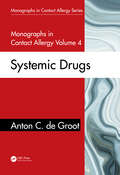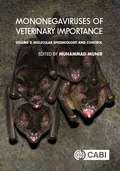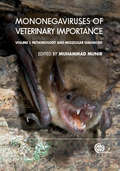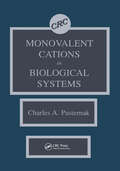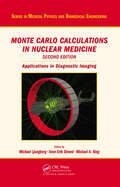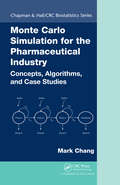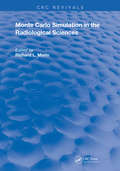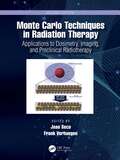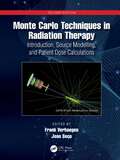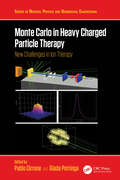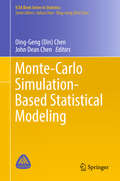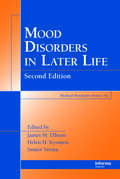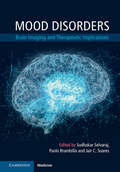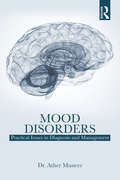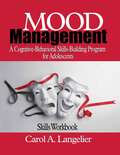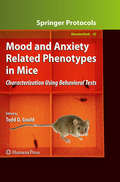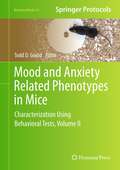- Table View
- List View
Monographs in Contact Allergy, Volume 4: Systemic Drugs (Monographs in Contact Allergy #4)
by Anton C. de GrootThis fourth volume in an exciting and detailed series on contact allergens and drug allergy provides monographs of all 507 systemic drugs which have caused delayed-type cutaneous drug hypersensitivity reactions and/or occupational allergic contact dermatitis. The monographs present: Identification section; Occupational allergic contact dermatitis; and Cutaneous adverse drug reactions from systemic drugs caused by type IV (delayed-type) hypersensitivity, as shown by positive patch tests (e.g. maculopapular eruption, acute generalized exanthematous pustulosis [AGEP], symmetrical drug-related intertriginous and flexural exanthema [SDRIFE], fixed drug eruption, drug reaction with eosinophilia and systemic symptoms [DRESS], and photosensitivity). Separate chapters present an overview of the spectrum of allergic cutaneous drug reactions, diagnostic tests, immediate contact reactions (contact urticaria), and systemic drugs that have acquired delayed-type hypersensitivity only by cross-reactivity. Key Features: Presents monographs of all known systemic drugs which have caused delayed allergic cutaneous drug reactions and/or occupational allergic contact dermatitis Provides an extensive literature review of relevant topics of allergenic systemic drugs, part of which is hard or impossible to find in database searches Identifies IUPAC names, synonyms, CAS and EC numbers, structural and chemical formulas, Merck Index monographs, and advises on patch testing Presents immediate contact reactions (contact urticaria) from systemics drugs and delayed-type hypersensitivity in drugs caused only by cross-reactivity Covers an extensive amount of information to benefit dermatologists, allergists, and all others interested in drug allergy
Monographs in Contact Allergy: Fragrances and Essential Oils (Monographs in Contact Allergy #2)
by Anton C. de GrootThis second volume in an exciting and detailed series on contact allergens provides monographs of all 181 fragrances and 79 essential oils which have caused contact allergy / allergic contact dermatitis, including the indicators for fragrance allergy (fragrance mixes I and II and Myroxylon pereirae resin [Balsam of Peru]) and non-fragrance allergens in botanical products used in the perfume industry. The monographs present: Identification section; Contact allergy (general population, patients with dermatitis, case reports and case series); Cross-reactions; Patch test sensitization; Presence in products and chemical analyses; Other side effects (irritant contact dermatitis, photosensitivity, immediate-type reactions, systemic side effects) and more. Key Features: Presents monographs of all known fragrance chemicals and essential oils which have caused contact allergy / allergic contact dermatitis Provides a full literature review of relevant topics of allergenic fragrances and essential oils Identifies INCI and IUPAC names, synonyms, CAS and EC numbers, structural formulas, RIFM and Merck Index monographs, SCCS opinions, IFRA and EU restrictions and advises on patch testing Presents an alphabetical list of all synonyms indicating their INCI names Covers an extensive amount of information to benefit dermatologists, allergists, and non-medical professionals involved with the research, development and marketing of fragrances and essential oils
Mononegaviruses of Veterinary Importance
by Muhammad MunirThe Mononegavirales is an order of viruses affecting large, small and marine animals and is responsible for diseases including Rinderpest, Rabies and Ebola. This book discusses the epidemiology and control of Mononegaviruses that pose a significant threat to animals in terms of severity and epidemiological risk. The book also addresses viruses with zoonotic potential, and many that can be used as models in the study of infectious disease. With its comprehensive coverage, each chapter is dedicated to a different disease and has been authored by renowned scientists who have made seminal contributions to the field. This prestige reference work is arranged over two volumes: volume 1 pathobiology and molecular diagnosis, and volume 2 molecular epidemiology and control. This broad ranging text covers mononegaviral diseases of livestock, horses, dogs and cats as well as rodents, primates, fish and marine mammals, and will be a valuable reference source for virologists, field veterinarians, infection and molecular biologists as well as immunologists and animal scientists.
Mononegaviruses of Veterinary Importance, Volume 1: Pathobiology and Molecular Diagnosis
by David Lyon Simon Goodman John Ellis Siamak Zohari Joseph Domachowske Associate Professor Arun Dhar Jonas Wensman Anke Brüning-Richardson Jorge Moreno-Lopez Branka Horvat Elankumaran Subbiah Veronica Von Messling Wenzhi Xue Changging Qui Zhen Fu Washington Cárdenas Christopher Basler Sara Soto Manika Suryadevera Niels Jørgen Olesen Carol Kim Silke Rautenschlein Gene Olinger* Discusses the pathology and laboratory diagnosis of viruses that carry a significant threat to animals in terms of their severity and epidemiological risk * Also looks at mononegavirales that are used as models in the study of infectious disease * Includes viruses with zoonotic potential
Mononegaviruses of Veterinary Importance, Volume 2: Molecular Epidemiology and Control
by Mikael Berg Jens H Kuhn Associate Professor Arun Dhar Andrew Orry F C Allnutt Paula Kinnunen Jonas Wensman Bronwyn A Clayton Ina Smith Glenn Marsh Somporn Somporn Watanyoo Pratakpiriya Muhammad Zubair Shabbir Anke Brüning-Richardson Satya Parida Ashley C Banyard Fernando Rosado Spilki Sandra Cuevas-Romero Jorge Moreno-Lopez Marina Mozgovoj María José Santos Mattia Cecchinato Helena Lage Ferreira Elena Catelli Paulo Eduardo Brandão Steven B Bradfute Peter P Jahrling Consuelo Rubio-Guerri Jose Manuel Sánchez-Vizcaíno Refugio Robles-SikisakaThe Mononegavirales is an order of viruses affecting large, small and marine animals and is responsible for diseases including Rinderpest, Rabies and Ebola. This book discusses the epidemiology and control of Mononegaviruses that pose a significant threat to animals in terms of severity and epidemiological risk. The book also addresses viruses with zoonotic potential, and many that can be used as models in the study of infectious disease. With its comprehensive coverage, each chapter is dedicated to a different disease and has been authored by renowned scientists who have made seminal contributions to the field. This prestige reference work is arranged over two volumes: volume 1 pathobiology and molecular diagnosis, and volume 2 molecular epidemiology and control. This broad ranging text covers mononegaviral diseases of livestock, horses, dogs and cats as well as rodents, primates, fish and marine mammals, and will be a valuable reference source for virologists, field veterinarians, infection and molecular biologists as well as immunologists and animal scientists.
Monovalent Cations in Biological Systems
by Charles A. PasternakThis unique volume provides an integrated overview of the subject of monovalent cations, specifically aimed at students and researchers. It is divided into two parts: the first deals with the processes by which monovalent cations are transported across biological membranes; the second deals with the processes that are affected by changes in intracellular cations. Each chapter describes in simple biochemical terms the interaction between one or more monovalent cations and a particular biological system of importance to current understanding of body function in health and disease. This useful publication is invaluable to students and researchers in biochemistry, physiology, neurology, pharmacology, anesthesiology, cardio-pulmonology, hematology, laboratory medicine, endocrinology, gastroenterology, internal medicine, psychiatry, urology, biomedical physics and medical nutrition.
Monsters, Demons and Psychopaths: Psychiatry and Horror Film
by Fernando Espi ForcenDescriptions of monsters, vampires, demonic possessions, and psychopaths in horror films have been inspired by psychiatric knowledge about mental illness, leading to several stereotyped models of horror that have prevailed through decades. Some scholars have proposed that horror films can be a teaching tool for psychopathology, but for the most part the genre has been underutilized as a learning tool. This book explores the idea of relating horror films to psychiatric ideas as a way of engaging people in learning.
Monstrous Crimes and the Failure of Forensic Psychiatry
by John Douard Pamela D. SchultzThe metaphor of the monster or predator--usually a sexual predator, drug dealer in areas frequented by children, or psychopathic murderer--is a powerful framing device in public discourse about how the criminal justice system should respond to serious violent crimes. The cultural history of the monster reveals significant features of the metaphor that raise questions about the extent to which justice can be achieved in both the punishment of what are regarded as "monstrous crimes" and the treatment of those who commit such crimes. This book is the first to address the connections between the history of the monster metaphor, the 19th century idea of the criminal as monster, and the 20th century conception of the psychopath: the new monster. The book addresses, in particular, the ways in which the metaphor is used to scapegoat certain categories of crimes and criminals for anxieties about our own potential for deviant, and, indeed, dangerous interests. These interests have long been found to be associated with the fascination people have for monsters in most cultures, including the West. The book outlines an alternative public health approach to sex offending, and crime in general, that can incorporate what we know about illness prevention while protecting the rights, and humanity, of offenders. The book concludes with an analysis of the role of forensic psychiatrists and psychologists in representing criminal defendants as psychopaths, or persons with certain personality disorders. As psychiatry and psychology have transformed bad behavior into mad behavior, these institutions have taken on the legal role of helping to sort out the most dangerous among us for preventive "treatment" rather than carceral "punishment."
Montana Actually
by Fiona LoweA big-city doctor in a small-town Montana practice....A former nurse who has sworn off doctors forever....The scene is set for passions to ignite in Big Sky Country. For readers of Robyn Carr and Sherryl Woods. City doctor Josh Stanton and his sports car don't suit the country, but with his medical school debt about to bury him, Josh has to make the best out of a bad situation. Adjusting to his new job and life in the middle of nowhere isn't easy, but at least the views of the mountains--and one distractingly attractive local--are stunning... After eight years away, Katrina McCade is back in Bear Paw for a break from her life, bad choices--and men. But when a broad-shouldered stranger bursts into town, she finds herself unexpectedly saddled with the town's sexy new doctor as a tenant. Katrina doesn't need a man to make her happy, especially a disgruntled physician. But try telling her body that... "This is a funny, sexy, and heart-warming novel that I feel is a must-read and a keeper. It made me laugh. I loved each character, and wish I could visit Bear Paw." Catherine Anderson, New York Times bestselling author of Silver Thaw "Delightful." --Publishers Weekly (starred review)
Montana's Hot Springs (Images of America)
by Jeff BirkbyMontana's hot springs and hot water resorts bubble with fascinating histories of medical cures, Native American legends, glittering spas, and isolated wilderness soaks. These Montana hot springs provided soothing cures for the aches and pains of Native Americans and early Montana pioneers. A few of the crude bathhouses built by miners and settlers gave way to ornate bathing resorts, replete with some of the most elegant furnishings and facilities available between Minneapolis and San Francisco, from the 1890s through the 1920s. Grand hot springs resorts--including Corwin Hot Springs, Boulder Hot Springs, Hunter's Hot Springs, and Broadwater Hot Springs--flourished and then faded from Montana's landscape. Through photographs, Images of America: Montana's Hot Springs explores the stories and legends of hot-water bathing resorts in Montana.
Monte Carlo Calculations in Nuclear Medicine: Applications in Diagnostic Imaging (Series in Medical Physics and Biomedical Engineering)
by Michael Ljungberg Sven-Erik Strand Michael A. KingFrom first principles to current computer applications, Monte Carlo Calculations in Nuclear Medicine, Second Edition: Applications in Diagnostic Imaging covers the applications of Monte Carlo calculations in nuclear medicine and critically reviews them from a diagnostic perspective. Like the first edition, this book explains the Monte Carlo method
Monte Carlo Simulation for the Pharmaceutical Industry: Concepts, Algorithms, and Case Studies (Chapman & Hall/CRC Biostatistics Series)
by Mark ChangHelping you become a creative, logical thinker and skillful "simulator," Monte Carlo Simulation for the Pharmaceutical Industry: Concepts, Algorithms, and Case Studies provides broad coverage of the entire drug development process, from drug discovery to preclinical and clinical trial aspects to commercialization. It presents the theories and metho
Monte Carlo Simulation in the Radiological Sciences (Routledge Revivals)
by Richard L. MorinFirst Published in 1988, this book offers a full exploration into the applications of the Monte Carlo Simulation. Carefully compiled and filled with a vast repertoire of notes, diagrams, and references this book serves as a useful reference for Students of Radiology, and other practitioners in their respective fields.
Monte Carlo Techniques in Radiation Therapy: Applications to Dosimetry, Imaging, and Preclinical Radiotherapy (Imaging in Medical Diagnosis and Therapy)
by Joao SecoThoroughly updated throughout, this second edition of Monte Carlo Techniques in Radiation Therapy: Applications to Dosimetry, Imaging, and Preclinical Radiotherapy, edited by Joao Seco and Frank Verhaegen, explores the use of Monte Carlo methods for modelling various features of internal and external radiation sources. Monte Carlo methods have been heavily used in the field of radiation therapy in applications such as dosimetry, imaging, radiation chemistry, modelling of small animal irradiation units, etc. The aim of this book is to provide a compendium of the Monte Carlo methods that are commonly used in radiation therapy applications, which will allow students, postdoctoral fellows, and university professors to learn and teach Monte Carlo techniques. This book provides concise but detailed information about many Monte Carlo applications that cannot be found in any other didactic or scientific book. This second edition contains many new chapters on topics such as: Monte Carlo studies of prompt gamma emission Developments in proton imaging Monte Carlo for cone beam CT imaging Monte Carlo modelling of proton beams for small animal irradiation Monte Carlo studies of microbeam radiation therapy Monte Carlo in micro- and nano-dosimetry GPU-based fast Monte Carlo simulations for radiotherapy This book is primarily aimed at students and scientists wishing to learn and improve their knowledge of Monte Carlo methods in radiation therapy.
Monte Carlo Techniques in Radiation Therapy: Introduction, Source Modelling, and Patient Dose Calculations (Imaging in Medical Diagnosis and Therapy)
by Frank VerhaegenAbout ten years after the first edition comes this second edition of Monte Carlo Techniques in Radiation Therapy: Introduction, Source Modelling, and Patient Dose Calculations, thoroughly updated and extended with the latest topics, edited by Frank Verhaegen and Joao Seco. This book aims to provide a brief introduction to the history and basics of Monte Carlo simulation, but again has a strong focus on applications in radiotherapy. Since the first edition, Monte Carlo simulation has found many new applications, which are included in detail. The applications sections in this book cover the following: Modelling transport of photons, electrons, protons, and ions Modelling radiation sources for external beam radiotherapy Modelling radiation sources for brachytherapy Design of radiation sources Modelling dynamic beam delivery Patient dose calculations in external beam radiotherapy Patient dose calculations in brachytherapy Use of artificial intelligence in Monte Carlo simulations This book is intended for both students and professionals, both novice and experienced, in medical radiotherapy physics. It combines overviews of development, methods, and references to facilitate Monte Carlo studies.
Monte Carlo in Heavy Charged Particle Therapy: New Challenges in Ion Therapy (Series in Medical Physics and Biomedical Engineering)
by Pablo Cirrone Giada PetringaThis book explores the current difficulties and unsolved problems in the field of particle therapy and, after analysing them, discusses how (and if) innovative Monte Carlo approaches can be used to solve them. Each book chapter is dedicated to a different sub-discipline, including multi-ion treatments, flash-radiotherapy, laser-accelerated beams, nanoparticles effects, binary reactions to enhance radiobiology, and space-related issues. This is the first book able to provide a comprehensive insight into this exciting field and the growing use of Monte Carlo in medical physics. It will be of interest to graduate students in medicine and medical physics, in addition to researchers and clinical staff. Key Features: Explores the exciting and interdisciplinary topic of Monte Carlo in particle therapy and medicine. Addresses common challenges in the field. Edited by an authority on the subject, with chapter contributions from specialists. Pablo Cirrone is a medical physicist and researcher at the Laboratori Nazionali del Sud of INFN, Italy, where he supports and coordinates various experimental groups. Dr. Cirrone is an expert in the use of proton and ion in radiation treatment and of absolute and relative dosimetry in electron, photon and ion beam. He is an expert in the development and test of detectors for medical applications, of the production and use of laser-driven beams for medical and multidisciplinary applications and recipient of the Michael Gotein Award. He is active on many scientific committees and organizes national and international conferences. Giada Petringa is a researcher at the Laboratori Nazionali del Sud of INFN, Italy. Dr. Petringa has a professional experience in the field of Monte Carlo simulations for medical applications, dosimetry, microdosimetry, and diagnostics with conventional and laser-driven proton beams. In 2019 she had a MSCA-IF-2019 (Marie Sklodowska-Curie Actions-Individual Fellowship) grant funded by the European Community in the framework of the H2020 program. She is a member of the Editorial Board of the international journal Physica Medica - European Journal of Medical. She organized more than fifteen international Geant4 Schools. She is an official member of the Geant4 code Collaboration at CERN since 2019. She is a code developer, and she collaborates to maintain two of the official examples of the code.
Monte-Carlo Simulation-Based Statistical Modeling
by Ding-Geng Din Chen John Dean ChenThis book brings together expert researchers engaged in Monte-Carlo simulation-based statistical modeling, offering them a forum to present and discuss recent issues in methodological development as well as public health applications. It is divided into three parts, with the first providing an overview of Monte-Carlo techniques, the second focusing on missing data Monte-Carlo methods, and the third addressing Bayesian and general statistical modeling using Monte-Carlo simulations. The data and computer programs used here will also be made publicly available, allowing readers to replicate the model development and data analysis presented in each chapter, and to readily apply them in their own research. Featuring highly topical content, the book has the potential to impact model development and data analyses across a wide spectrum of fields, and to spark further research in this direction.
Mood Disorders and Antidepressants
by Stephen M. Stahl Nancy MuntnerWith the fully revised fourth edition of Essential Psychopharmacology, Dr Stahl returns to the essential roots of what it means to become a neurobiologically empowered psychopharmacologist, expertly guided in the selection and combination of treatments for individual patients in practice. This remains the essential text for all students and professionals in mental health seeking to understand and utilize current therapeutics, and to anticipate the future for novel medications. This special edition, featuring the extracted chapters on mood disorders and antidepressants, provides a readable digest on these specific issues for experts and novices alike.
Mood Disorders in Later Life (Medical Psychiatry Series)
by Paul C. EtterMood Disorders in Later Life examines the spectrum of mood disorders in older adults, focusing on major and nonmajor depressive disorders, bipolar disorder (manic and depressive phases), depression with psychotic features, and vascular depression. In depth discussions of diagnosis and treatment options including psychotherapy, pharmacotherapy, and
Mood Disorders: Brain Imaging and Therapeutic Implications
by Paolo Brambilla Sudhakar Selvaraj Jair C SoaresMood disorders such as depression and bipolar disorder are common mental illnesses, affecting millions of patients worldwide. The application of newly available brain imaging methods to the study of mood disorders holds substantial promise in uncovering the brain mechanisms affected in these illnesses. This comprehensive and authoritative text features contributions from leading international experts, providing easily accessible information on the study of the brain mechanisms involved in the causation of mood disorders and the available treatments. Topics covered include the potential of magnetoencephalography (MEG), neuroimaging brain inflammation in depression, electrophysiology studies in mood disorders, and the applications of machine learning, filling an important gap in available neuropsychiatric literature and highlighting new developments. An invaluable resource for practitioners in the fields of psychiatry, neurology, primary care medicine, and related mental health professions, as well as researchers, students, graduate and post-graduate trainees.
Mood Disorders: Practical Issues in Diagnosis and Management
by Ather MuneerMood Disorders: Practical Issues in Diagnosis and Management provides cutting edge knowledge about the diagnosis and treatment of principal mood disorders, namely major depressive disorder and bipolar disorder. Covering diagnosis, differentiating features, and illness course and trajectories of principal mood disorders, Dr. Ather Muneer provides essential information in a succinct and practical manner, while highlighting significant new findings in the area. This book will help a broad range of mental health professionals better treat the millions of people with mood disorders across the globe.
Mood Management: A Cognitive-behavioral Skills-building Program For Adolescents; Skills Workbook
by Carol A. LangelierWritten at a level that is easy for adolescents to understand, this illustrated skills workbook features exercises and checklists for participants to use as they work through the Mood Management program.
Mood Stabilizers
by Stephen M. Stahl Nancy Muntner Sara BallAll of the titles in the Stahl s Illustrated Series are designed to be fun. Concepts are illustrated by full-color images that will be familiar to all readers of Stahl s Essential Psychopharmacology, Third Edition and The Prescriber s Guide. The texts in this user-friendly series can be supplements to figures, images, and tables. The visual learner will find that these books make psychopharmacology concepts easy to master, while the non-visual learner will enjoy a shortened text version of complex psychopharmacology concepts. Within each book, each chapter builds on previous chapters, synthesizing information from basic biology and diagnostics to building treatment plans and dealing with complications and comorbidities. Novices may want to approach Stahl s Illustrated Series by first looking through all the graphics and gaining a feel for the visual vocabulary. Readers more familiar with these topics should find that going back and forth between images and text provides an interaction with which to vividly conceptualize complex pharmacologies. And, to help guide the reader toward more in-depth learning about particular concepts, each book ends with a Suggested Reading section. ************************************** CME Information Sponsor This activity is sponsored by Neuroscience Education Institute. Support This activity is supported solely by the sponsor, Neuroscience Education Institute. Neither the Neuroscience Education Institute nor Stephen M. Stahl, MD, PhD, has received any funds or grants in support of this educational activity. Accreditation and Credit Designation Statements The Neuroscience Education Institute is accredited by the Accreditation Council for Continuing Medical Education to provide continuing medical education for physicians. The Neuroscience Education Institute designates this educational activity for a maximum of 3. 0 AMA PRA Category 1 Credits TM. Physicians should only claim credit commensurate with the extent of their participation in the activity. Non-physicians may receive a certificate of participation for completing this activity. CME Credit Expiration Date: June, 2011
Mood and Anxiety Related Phenotypes in Mice
by Todd D. GouldAffecting approximately twenty percent of the world population, mood and anxiety disorders have been the subject of ever-increasing research. This increased research parallels a remarkable growth in the use of the laboratory mouse as a tool to understand the biological and genetic basis of mood and anxiety disorders as well as to develop improved treatments. In Mood and Anxiety Related Phenotypes in Mice: Characterization Using Behavioral Tests, world-renowned researchers provide an overview of behavioral approaches utilized in the characterization of mood and anxiety related behaviors in mice as well as commonly used behavioral assays to assess the potential antidepressant and anxiolytic efficacy of novel compounds. As a volume in the successful NeuromethodsTM series, the chapters provide authoritative reviews including up-to-date detailed protocols of the most commonly used approaches in the field. Mood and Anxiety Related Phenotypes in Mice: Characterization Using Behavioral Tests is an ideal resource for scientists actively pursuing or interested in establishing behavioral protocols in their laboratories, while also serving as a reference for those students, scientists, and practitioners who have an interest in better understanding the preclinical behavioral methods used in mood and anxiety research.
Mood and Anxiety Related Phenotypes in Mice, Volume II
by Todd D. GouldPreclinical research related to mood and anxiety disorders relies extensively upon mouse behavioral tests and models, the use of which continues to increase as a greater number of underlying susceptibility genes are discovered, new targets for medications are identified, and clinical studies reveal novel neurobiological risk factors. Mood and Anxiety Related Phenotypes in Mice: Characterization Using Behavioral Tests, Volume II serves as a complement to the previous volume in order to offer a comprehensive resource for the behavioral approaches that are valuable for the characterization of mood and anxiety disorder-related behaviors in mice and the techniques that are utilized in the development of effective medications. As a collection presented in the Neuromethods series, each chapter provides a brief background and review of the test or model as well as a complete and up-to-date protocol narrative.<P><P> Authoritative and comprehensive, Mood and Anxiety Related Phenotypes in Mice: Characterization Using Behavioral Tests, Volume II is an ideal resource for scientists actively pursuing or interested in establishing vital behavioral protocols in their laboratories.
